To mark the centennial of the publication of The Great Gatsby by F. Scott Fitzgerald (1896–1940), CHM director of exhibitions Paul Durica writes about the novel’s many connections to Chicago.
Like the green light at the end of Tom Buchanan’s dock, the city of Chicago remains present yet out of reach throughout the text of The Great Gatsby, F. Scott Fitzgerald’s classic novel that turns 100 this year.
Chicago is where Buchanan is from, the source of his family’s vast wealth. The “string of polo ponies” on his East Coast estate hails from Lake Forest, located about 27 miles north of the Loop. Chicago is where he and his wife Daisy, originally from Louisville, lived before their move to Long Island. The first thing she asks her “second cousin once removed,” Nick Carraway, the novel’s narrator, is if people miss her in Chicago. “The whole town is desolate,” he replies. “[T]here’s a persistent wail all night along the North Shore.”
Buchanan money is old money, at least by Chicago standards. The novel’s title character Jay Gatsby depends upon the city for his wealth as well, albeit from more illegal sources.
When Nick first meets his neighbor Gatsby at one of the latter’s lavish parties, he quickly excuses himself upon learning that “Chicago was calling him on the wire,” presumably in connection with his bootlegging ventures. Later, Nick meets one of Gatsby’s associates, the gambler Meyer Wolfshiem, casually identified as the “man who fixed the World’s [sic] Series back in 1919,” the one involving the Chicago “Black Sox.”
All these references to Chicago in a novel set entirely in New York are intentional. For Fitzgerald, Chicago is both the gateway and stand-in for the greater Midwest. Late in the novel, Nick remembers train trips “coming back west from prep school and later from college at Christmas time.” These trips always involved a stopover in the “old dim Union Station” in Chicago where those staying would exchange some “holiday gayeties” with those continuing on. It was only after leaving Chicago that Nick experienced the “winter night and the real snow, our snow” as the “dim lights of small Wisconsin stations” passed by the train’s windows. This landscape he regards as “my middle west.”
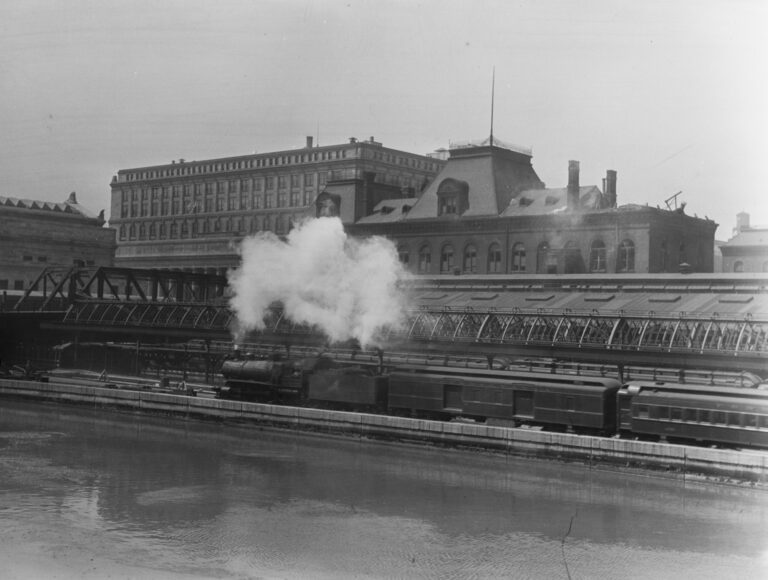
Exterior view of the old and new Union Station buildings seen from the Monroe Street Bridge, Chicago, 1925. A Pennsylvania Railroad train is passing in the foreground. CHM, ICHi-073561
“I see now that this has been a story of the West, after all,” Nick muses, in the aftermath of Gatsby’s murder, brought about by his failed dream of reclaiming his lost love, Daisy. “Tom and Gatsby, Daisy and Jordan and I, were all Westerners, and perhaps we possessed some deficiency in common which made us subtly unadaptable to Eastern life.”
The public lives of the Chicagoans who served as the models for the golfer Jordan Baker, as well as Tom and Daisy Buchanan, suggest they didn’t share the “deficiency” of their fictional counterparts.
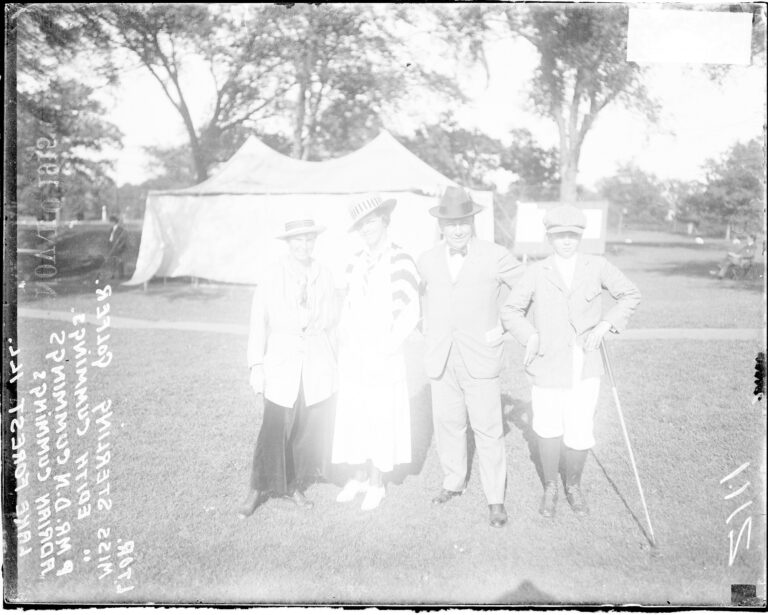
From left: Alexa Sterling, a golfer, with Edith, D. N., and Adrian Cummings, standing in front of a tent at the Onwentsia Country Club, Lake Forest, Illinois, November 1915. Edith Cummings defeated Stirling for the 1923 women’s amateur title in Rye, New York. DN-0065346, Chicago Daily News Collection, CHM
Charles Scribner’s Sons published The Great Gatsby on April 10, 1925. The following day the society page in The Chicago Daily Tribune shared that Edith Cummings would not be “going to England this spring to compete with our neighbors over the sea in the British golf tournament,” as had been rumored, but would be staying in Chicago.
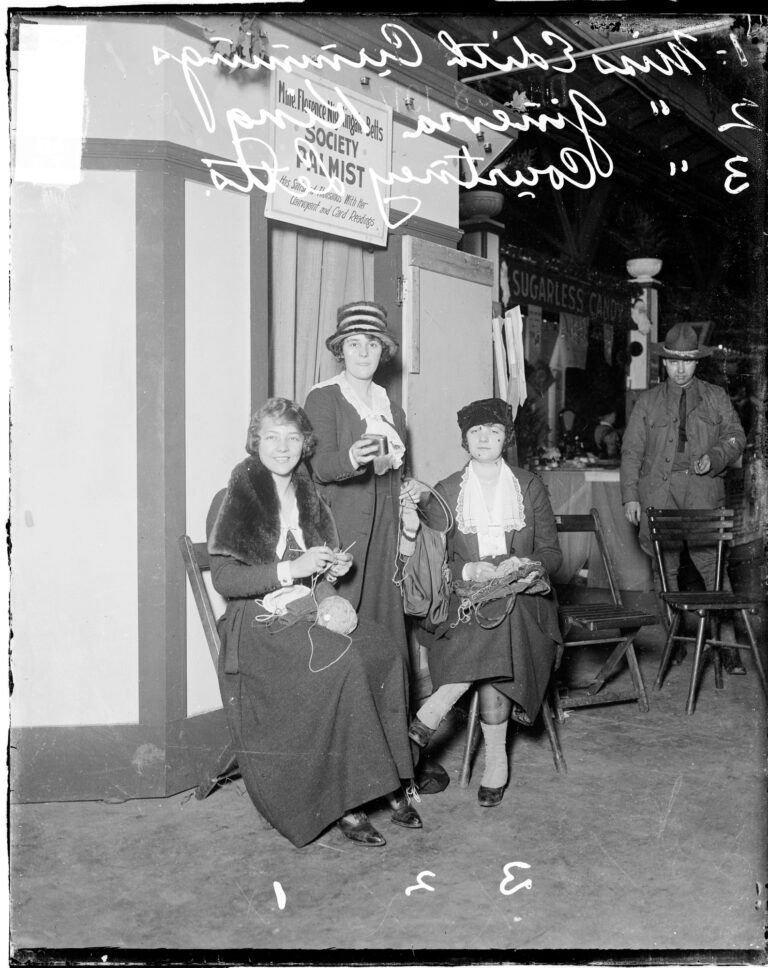
From left: Edith Cummings, Gineva King (standing), and Courtney Letts at an event for the Christmas Fund for French Children, Chicago, 1917. DN-0069439, Chicago Daily News collection, CHM
Edith Cummings (1899–1984) was the model for Daisy’s friend and Nick’s romantic interest, Jordan Baker. Like Baker, she was young, from a prominent family, and known for her athleticism. In 1923, she came from behind to win the women’s amateur golf title at Rye, New York. Her success as a golfer landed her on the cover of Time. She was an avid skier as well and would play a small part in fellow Chicagoans Walter and Elizabeth Paepcke falling in love with an old mining town in Colorado, known for its excellent slopes, which they’d transform into a premier resort and center of intellectualism, Aspen.
That same society column from April 10 mentions one of Cummings’s closest friends, “Mrs. William H. Mitchell.” She was among “four of society’s fairest” who’d been chosen to “model for Vogue at the Woman’s World’s Fair,” opening the following week. As was the convention in 1925, “Mrs. William H. Mitchell,” was identified by her husband’s name. They had married in 1918, in a service held at St. Chrysostom’s Episcopal Church, on Dearborn Street, a short walk from the Chicago History Museum.
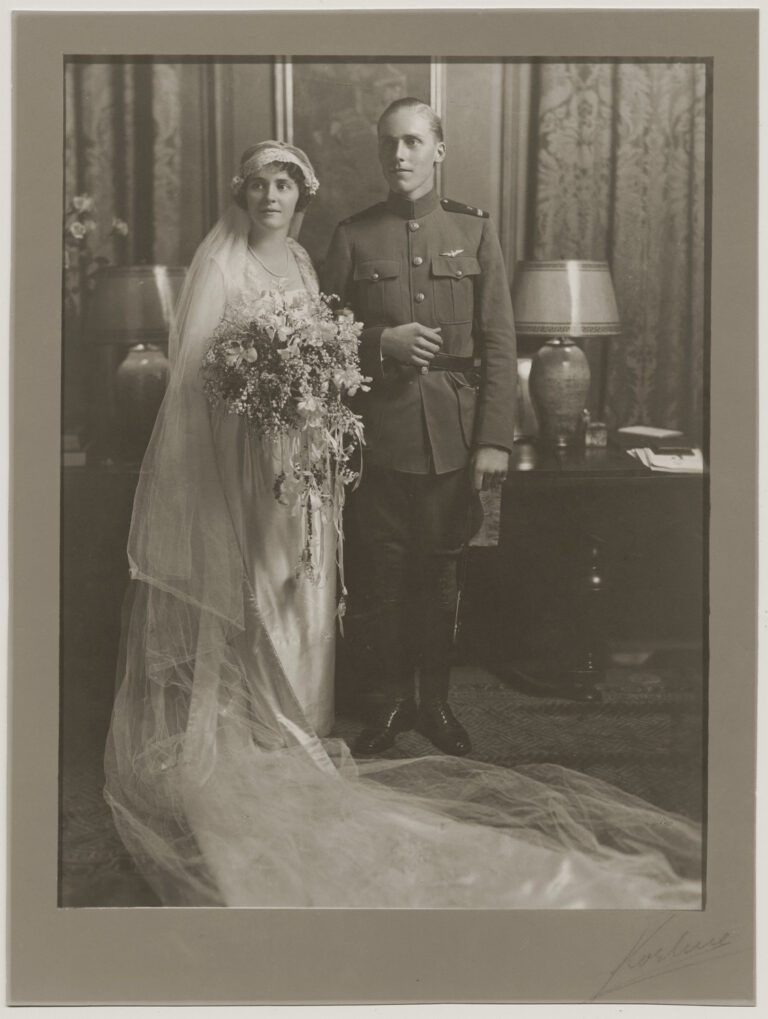
Wedding portrait of William H. Mitchell and Ginevra King Mitchell, c. 1918. CHM, ICHi-054512
William H. Mitchell (1895–1987) was the model for the polo-playing Tom Buchanan. He came from a respected family of bankers. His public life was punctuated with moments of drama and tragedy fit for a novel. Mitchell served with distinction as an aviator in World War I. About a decade after his marriage and two years after the publication of Gatsby, he lost his parents in an automobile accident. His father, who’d played an important role in shaping the Federal Reserve, left his son with the very Tom Buchanan-appropriate advice that “success comes to the man who engages in business as in a game, because he is interested enough to play hard.” Mitchell and his wife lived in a mansion in Lake Forest, where in 1931, they and several guests were robbed of money and jewelry at gunpoint by a gang of thieves. When the latter were brought to trial, public sympathy seemed more with them than with the Mitchells, who’d maintained their wealth during the Great Depression.
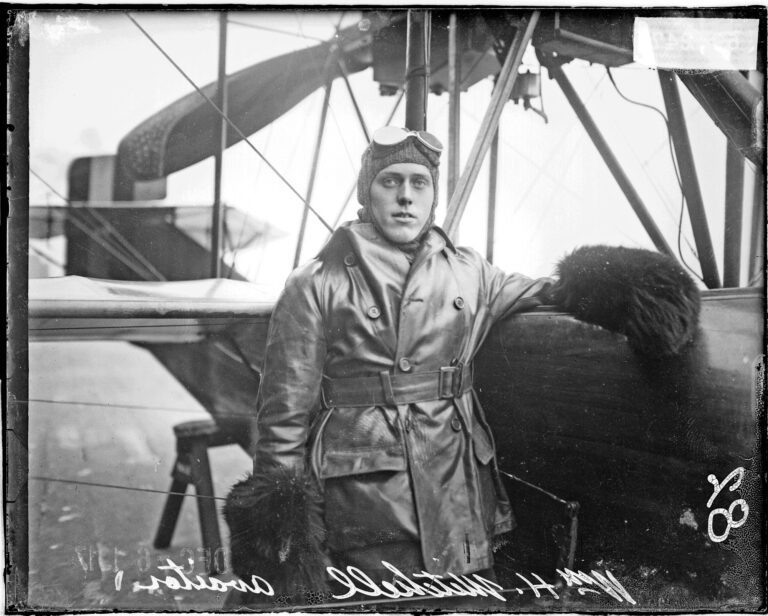
William H. Mitchell standing next to an airplane that is resting on sawhorses, Chicago, 1917. DN-0069247, Chicago Daily News collection, CHM
By that time, Mitchell’s marriage was faltering. His wife, Ginevra King (1898–1980), would ultimately leave him. King has the strongest connection to Gatsby, being the inspiration, as acknowledged by Fitzgerald himself, of Daisy Buchanan. As Daisy was for Gatsby, Ginevra King was the great, unobtainable love of F. Scott Fitzgerald’s life.
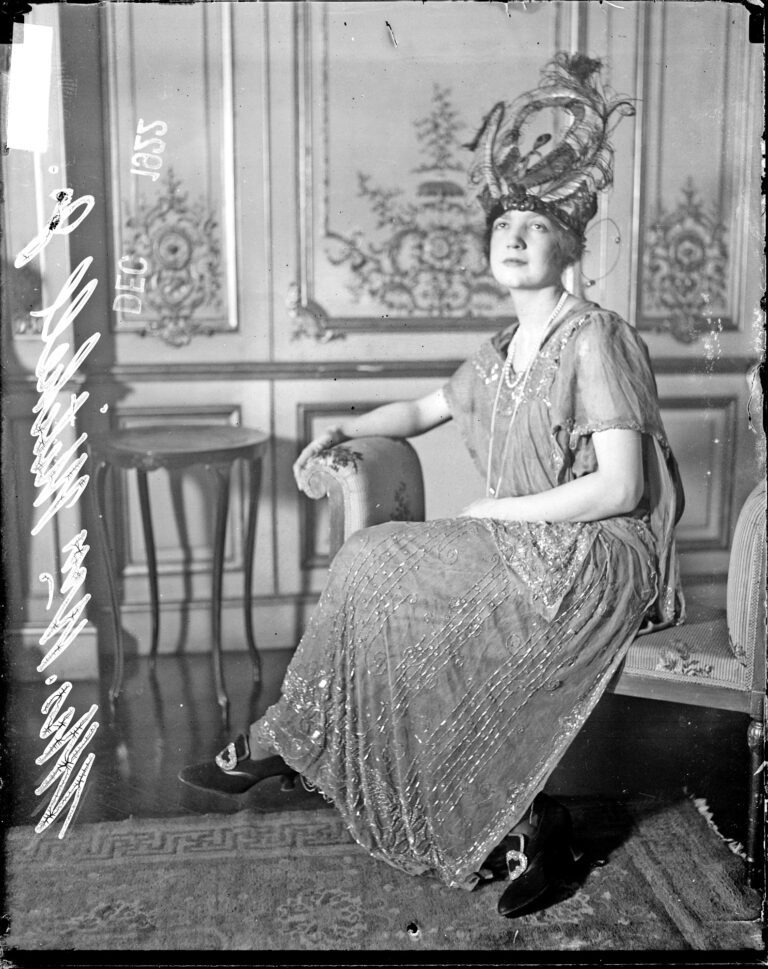
Ginevra King Mitchell (Mrs. William H. Mitchell) wearing a gown and a large headdress, Chicago, 1922. DN-0075229, Chicago Daily News collection, CHM
She came from old Chicago money and was raised on Astor Street and in Lake Forest. Like her good friend and bridesmaid Edith Cummings, King was admired for her athleticism but also for her volunteerism. She met Fitzgerald at age 16 when he was back in his native St. Paul, Minnesota, on holiday from Princeton University. The two continued to write to one another upon returning to their respective schools on the East Coast, and the 18-year-old Fitzgerald even traveled to Lake Forest to continue courting her. A strong emotional bond, particularly on the part of the aspiring writer, seemed to have formed, but marriage to one of wealthiest debutantes in Chicago was out of the question for this upper-middle-class Midwesterner. As someone, sometimes identified as Charles Garfield King, Ginevra’s father, told him, “Poor boys shouldn’t think of marrying rich girls.”
World War I profoundly impacted their lives, with a distraught Fitzgerald signing up to serve in the military and King doing what she could to support the soldiers on the home front. Afterward, they each found themselves in complicated marriages, with Fitzgerald wedding Zelda Sayre to whom he dedicated Gatsby.
Decades later, King and Fitzgerald reunited briefly in Hollywood, where the novelist was attempting to make it as a screenwriter. She apparently asked him which of his characters she’d inspired. An intoxicated Fitzgerald demeaned her in his response. King later married John T. Pirie Jr., heir to a department store fortune. Fitzgerald died in Hollywood in 1940 at the age of 44.
Ginevra King Pirie died at the age of 82 in 1980. Her Chicago Tribune obituary mentioned her work as president of the Service Club of Chicago and leadership with the American Cancer Society. It does not mention that this Chicagoan was the inspiration for one of the great characters in American literature.
Sources
Borrelli, Christopher, “Real Daisy Bloomed on Chicago’s North Shore,” Chicago Tribune, May 7, 2013: C1.
“Extending Birthday Greetings to Two of Our Leading Citizens,” Chicago Daily Tribune, April 11, 1925: 19.
Fitzgerald, F. Scott. The Great Gatsby. New York: Charles Scribner’s Sons, 1925.
“J.J. Mitchell’s Rules for Life Are Told by Son,” Chicago Daily Tribune, November 4, 1927: 19.
“Miss Cummings is New Golf Queen,” Chicago Daily Tribune, October 7, 1923: A1.
“Mitchell Gem Gang Guilty,” Chicago Daily Tribune, January 17, 1932: 1.
“Obituaries,” Chicago Tribune, December 14, 1980: B27.
“Seize 3; Find $150,000 in Loot,” Chicago Daily Tribune, November 23, 1931: 1.
Thalia, “Chicagoans Live on Ranch in Colorado,” Chicago Daily Tribune, August 4, 1946: F1.